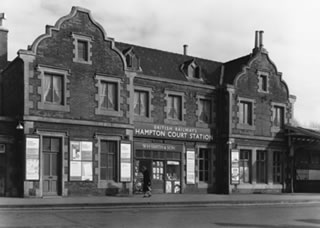The London and South-Western Railway (L&SWR) opened its line to Hampton Court in 1849, as a branch of the main line from Nine Elms to Woking. For some ten or eleven years previously passengers from Molesey wishing to travel to London had to first make their way to Surbiton Station (now Kingston Station).
Mr Andrews as “the Mole” writing in 1894 recalls the days when the railway first came. He says “when the railways first opened we used to be favoured with an only, but very special train, leaving Hampton at 1pm. It consisted I believe, of a third-class carriage and was drawn by a flea bitten grey, belonging to the only fly proprietor in the village” Perhaps we shouldn’t complain!
The station was built on the island formed between the rivers Mole and Ember and access was via a wooden bridge from Creek Road. As we know from Mr Mole for the first two years the carriages were pulled by horses. Regular steam locomotives then replaced the horses. By 1868 there were four lines and platforms and a railway turntable as well as coal depot and ancillary buildings on the site.
The peak capacity of this station was between 1912 and 1929 when over 10 sets of tracks fanned out at the site; four sets of tracks were designated for shuffle sidings (to augment services to the rest of the network); four were dedicated for the station itself and two lines were goods sidings for goods including bulk materials and the coal depot. During this period, a Thames side turntable was removed (the foundations of which were revealed upon redevelopment by Gladedale in May 2013). It is believed the turntable was re-established adjacent to Summer Road and Hampton Court Way.
In the 1930s the bed of the mouth of the Mole was filled in and the stream combined with the River Ember to construct Hampton Court Way and the Edward Lutyens-designed, re-aligned Hampton

